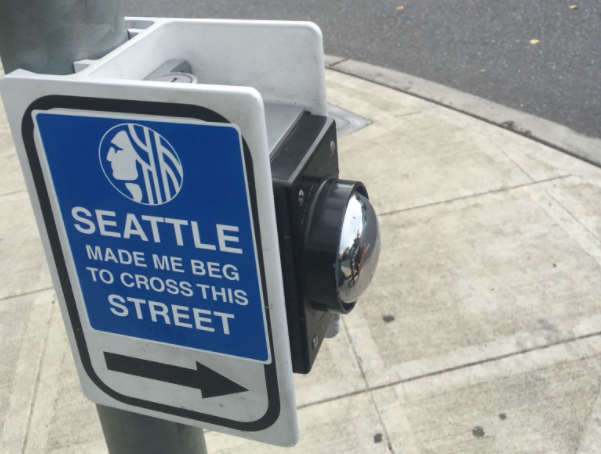Seattle’s transportation department missed the mark in their recent response to the campaign Give Pedestrians the Green. #GivePedstheGreen argues that in urban villages pedestrians should be automatically given the right (without having to push the “beg button”) to cross the intersection in the same direction as vehicular traffic when the light is green. However, in a post last week by the Seattle Department of Transportation (SDOT) entitled, “Why We Need the Pedestrian Push Button”, more questions than answers were created regarding how the transportation department will respond. Their article wrongly conflates signal re-programming with ADA (Americans with Disabilities Act) requirements to install physical beg buttons and suggests that futuristic technology will solve the problem.
By the standards of ADA, pedestrian push buttons are required because they provide audio and vibrotactile feedback to people with disabilities who are crossing the street. But that ADA requirement is separate from SDOT’s practice to program intersections to give drivers priority and require pedestrians to push a beg button in order to get a walk signal. #GivePedstheGreen isn’t an argument that beg buttons should be removed, just that they should be used differently. The buttons can still be there without being necessary in order for pedestrians to get a walk signal.
SDOT does acknowledge that beg buttons can be used differently, but does not offer solutions on how they can do that. The department is working toward drafting a new pedestrian signals policy by the end of the year, but they have not yet revealed any details or committed to improvements that will automatically activate the pedestrian signal when vehicles get a green light.
However, while we don’t know what’s in that draft policy, this article makes clear that people who want a safe and comfortable pedestrian environment should speak out. As if to distract us from the real issues facing people walking today and the need for concrete changes in the policy, SDOT touts the red herring of technology as the solution to pedestrian issues.
SDOT’s argument that passive pedestrian detection or soundscapes will solve problems for the pedestrian experience is both misguided and incorrect. Looking to technology for the answer is the same approach that incurred millions of dollars to deliver the adaptive signaling system on Mercer that hinders pedestrian movement and has been discredited by The Urbanist.
Rather than simply give people on foot the right to cross along with vehicle traffic in the same direction, SDOT continues to pursue “passive pedestrian detection”. This technology is supposed to know where people want to go and activate the signal for them. In some of the busy tourist areas, like 5th Ave N and Denny Way, people often approach an intersection and don’t even know which way they want to go themselves. How is a system going to know? Furthermore, if people don’t realize that they have to push a button today, how will they know that they need to stand in the right spot and face in the right direction for a system to give them the walk signal?
And one can only imagine the next technological frontier that SDOT will reach. Perhaps a partnership with Amazon to replace the pedestrian signals on Mercer Street with drones that pluck pedestrians by the head and lift them over vehicles to cross the street?
Even when SDOT’s new policy is released, reprogramming existing signals will cost money. At the current pace, SDOT’s signals group only has budget to reprogram five intersections per year. Signal improvements have the highest return on investment of any transportation improvement due to the amount of efficiency that all roadway users can reap from an efficiently designed system. Instead, SDOT offers unproven technology on Mercer Street and threatens a new way to slow down people on foot with passive pedestrian detection.
While SDOT is wrong about this, they accept that they need advocates to help them in the right direction. And, fortunately, people are getting louder. The initial petition to Give Pedestrians the Green has hundreds of signatures. And, recently, the unaffiliated Seattle Department of Transformation has created stickers that are appearing all over, shaming the city for its beg button programming.
Spotted at MLK and Columbian, along light rail where @seattledot should #GivePedstheGreen pic.twitter.com/d2B65UAxFT
— Walking in Seattle (@WalkingSeattle) October 7, 2017
SDOT says they’re listening. And now they need to hear from advocates who argue for straightforward and common-sense changes to make the pedestrian environment safer and more comfortable: just #GivePedstheGreen!
Troy is a pedestrian advocate who serves on the board of Seattle Neighborhood Greenways. He loves cities and walking, hiking, and biking. He wrote a book to help others looking to find the right place for them, called Move to the Place of Your Dreams: A Relocation Handbook. By day, he is a professional consultant for a technology firm.

